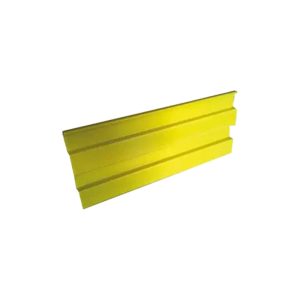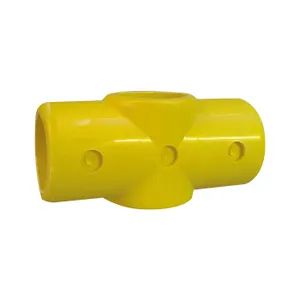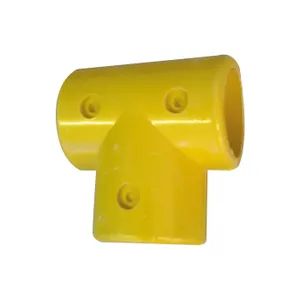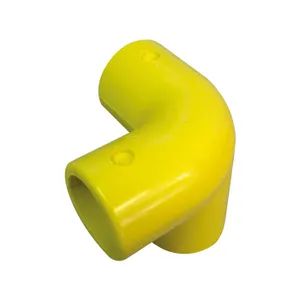Sistem pegangan GRP kami sering digunakan pada pegangan atau pagar pembatas GRP untuk meneruskan rel tengah pada sudut 90° atau menghubungkan tiang vertikal ke rel atas, atau untuk menyambungkan rel tengah ke tiang akhir.
Pengenalan kinerja produk
|
|
Putaran eksternal GRP adalah alat putar sejajar yang serbaguna, sering digunakan di mana sudut bervariasi pada lereng, anak tangga, dan pendaratan. |
|
GRP 116 Mid Corner adalah sambungan sudut 90°, sering digunakan pada pegangan GRP atau pagar pembatas untuk melanjutkan rel tengah pada sudut 90°, tetapi juga dapat digunakan untuk membangun struktur persegi panjang atau persegi. Bagian tegak melewati fitting GRP secara vertikal. Sering digunakan dengan Pojok Atas GRP-128. |
|
|
GRP 101 Short Tee adalah sambungan tee 90°, biasanya digunakan pada pegangan GRP untuk menyambungkan tiang vertikal ke rel atas, atau untuk menyambungkan rel tengah ke tiang ujung. Tabung tidak dapat disambung di bagian atas fitting-Tee Panjang GRP-104 dapat digunakan sebagai alternatif jika diperlukan. |
|
GRP Fitting 119 Midrail Cross adalah sambungan 90°, sering digunakan untuk menyambung rel tengah ke tiang tegak perantara di pegangan atau pagar pembatas GRP. Bagian tegak melewati fitting GRP secara vertikal. |
|
|
GRP 104 Long Tee adalah sambungan tee 90°, biasanya digunakan untuk menyambungkan tiang vertikal ke rel atas pegangan GRP. GRP -104 dapat digunakan ketika dua panjang tabung harus disambung di bagian atas fitting. |
|
Fitting GRP 125 adalah siku 90°, sering digunakan pada pegangan tangan GRP atau pagar pembatas untuk menghubungkan rel atas ke tiang tegak di akhir lari. |
|
|
GRP 129 adalah fitting tee 30°, sering digunakan pada pegangan tangga atau pagar pembatas GRP. |
|
Pemasangan 128 Sudut Atas adalah 3 arah. Siku 90°, biasanya digunakan untuk menyambung tiang tegak ke rel atas pegangan GRP pada sudut 90º. Sering digunakan dengan GRP-116 Mid Corner. |
|
|
GRP 130 adalah 30° Cross, sering digunakan untuk menghubungkan midrail ke tiang perantara di pegangan GRP tangga. |
|
GRP 116 Mid Corner adalah sambungan sudut 90°, sering digunakan pada pegangan GRP atau pagar pembatas untuk melanjutkan rel tengah pada sudut 90°, tetapi juga dapat digunakan untuk membangun struktur persegi panjang atau persegi. Bagian tegak melewati fitting GRP secara vertikal. Sering digunakan dengan Pojok Atas GRP-128. |
|
|
Pelat Dasar GRP 132 adalah flensa dasar dengan empat lubang pemasangan, digunakan untuk memasang tiang tegak pada pegangan atau pagar pembatas. |
|
GRP 173 Single Swivel adalah fitting putar serbaguna yang digunakan pada sudut yang berbeda-beda pada kemiringan, anak tangga, dan pendaratan. |
|
|
Soket Dinding 145 adalah Perlengkapan GRP yang dirancang untuk memasang pegangan tangan GRP atau pagar pembatas ke dinding, jalur landai, dan tangga. |  |
Pelat GRP Kick kami memiliki lebar 100mm, dengan dinding 5mm. Itu disimpan dalam panjang 6m tetapi dapat dipotong memanjang jika diperlukan. |
Dibuat di Cina plastik yang diperkuat kaca (GRP), sistem pegangan GRP TFcomposite menawarkan keunggulan utama dibandingkan baja yang menjelaskan mengapa Anda akan melihat pegangan GRP di mana-mana mulai dari pekerjaan pengolahan air hingga industri kereta api.
Fiberglass Reinforced Plastic (FRP) handrail systems are advanced, durable solutions for safety and access in industrial, commercial, and architectural applications. They are valued for their strength, corrosion resistance, and low maintenance, making them ideal for environments where traditional materials like steel or wood might fail due to exposure to harsh elements. Below is an in-depth exploration of FRP handrail systems, their components, benefits, applications, installation processes, and maintenance.
1. What is an FRP Handrail System?
An FRP handrail system is a modular or pre-engineered safety barrier system made from fiberglass reinforced plastic, a composite material that combines strong fibers with a polymer matrix. This results in a product that is lightweight, strong, and resistant to corrosion, chemicals, and UV exposure.
Key Components
FRP handrail systems typically consist of:
- Rails: The horizontal components providing continuous support.
- Posts: Vertical elements anchored to the ground or structure to support the rails.
- Knee Rails: Secondary horizontal rails for additional support and safety.
- Toe Boards: Base-level components to prevent tools or debris from falling.
- Perlengkapan: Connectors, brackets, and fasteners that hold the system together.
- Bases and Mounts: Used to anchor the system to floors, walls, or other surfaces.
2. Materials and Manufacturing
FRP handrail systems are produced using two main manufacturing methods:
- Pultrusion:
- Continuous fibers are pulled through a resin bath and a heated die.
- Ensures uniform strength and a smooth finish.
- cetakan:
- Fiberglass mats or woven roving are layered and infused with resin in a mold.
- Often used for complex or custom shapes.
Common Materials in FRP Handrails
- Fibers: Typically glass fibers for high tensile strength.
- Jenis Resin:
- Poliester: Cost-effective and moderately resistant to chemicals.
- Vinil Ester: Higher resistance to chemicals and heat.
- Epoxy: Superior mechanical strength and adhesion.
Additives like UV inhibitors, fire retardants, and pigments can be incorporated to enhance performance and aesthetics.
3. Key Benefits of FRP Handrail Systems
FRP handrail systems offer several advantages over traditional materials:
3.1. Corrosion Resistance
- Ideal for environments exposed to chemicals, saltwater, or moisture.
- Used in wastewater plants, marine applications, and chemical processing facilities.
3.2. Lightweight and Easy Installation
- Weighs significantly less than steel or aluminum, reducing transportation and labor costs.
- Modular designs often allow for easy assembly without specialized tools.
3.3. High Strength-to-Weight Ratio
- Provides comparable or superior strength to traditional materials with less bulk.
3.4. Durability and Longevity
- Resists cracking, warping, and degradation over time.
- Long service life even in extreme conditions.
3.5. Low Maintenance
- Requires no painting or frequent inspections.
- Resistant to rust and biological growth.
3.6. Electrical and Thermal Insulation
- Non-conductive, making it safe for electrical environments.
- Low thermal conductivity reduces the risk of burns in high-temperature areas.
3.7. Customizability
- Available in various colors, sizes, and configurations to suit specific requirements.
- Aesthetic options enhance compatibility with architectural designs.
4. Applications of FRP Handrail Systems
FRP handrails are used across diverse industries due to their adaptability and robust properties. Below are examples of key application areas:
4.1. Industrial Facilities
- Pabrik Kimia: Withstand chemical splashes and fumes.
- Oil and Gas: Non-corrosive properties ensure longevity in offshore and onshore facilities.
- Pembangkit Listrik: Non-conductive properties provide safety in electrical substations.
4.2. Water and Wastewater Treatment Plants
- Resistant to chlorine, acids, and moisture.
- Ideal for walkways, platforms, and tank access.
4.3. Marine and Coastal Environments
- Unaffected by saltwater corrosion.
- Used on docks, piers, and offshore platforms.
4.4. Public Infrastructure
- Bridges, parks, and pedestrian walkways where safety and aesthetics are essential.
4.5. Commercial and Residential
- Balconies, staircases, and ramps requiring modern, low-maintenance railings.
5. Design Standards and Compliance
FRP handrail systems are often designed to meet rigorous safety and engineering standards, including:
-
OSHA (Occupational Safety and Health Administration):
- Ensures compliance with workplace safety guidelines for handrails.
- Requires specific height, strength, and deflection properties.
-
ASTM (American Society for Testing and Materials):
- Provides testing standards for strength, durability, and material performance.
-
ISO (International Organization for Standardization):
- Covers quality and environmental safety standards globally.
-
ADA (Americans with Disabilities Act):
- Mandates handrail accessibility features, such as smooth surfaces and appropriate height.
6. Installation of FRP Handrail Systems
Installing an FRP handrail system involves the following steps:
6.1. Preparation
- Assess site conditions and ensure the surface is clean and level.
- Mark installation points based on a pre-approved layout or engineering design.
6.2. Assembly
- Install base mounts or brackets at marked points.
- Attach posts to the base mounts using bolts or adhesives.
- Secure horizontal rails and knee rails to the posts using brackets and fasteners.
- Attach toe boards if required.
6.3. Finishing
- Tighten all connections and inspect for alignment.
- Apply sealants or coatings if additional protection is needed.
6.4. Safety Testing
- Perform load tests to ensure compliance with safety standards.
- Inspect for any loose connections or misalignments.
7. Maintenance of FRP Handrail Systems
FRP systems require minimal upkeep, but periodic checks can ensure maximum performance:
7.1. Cleaning
- Use mild soap and water to remove dirt, debris, or grease.
- Avoid abrasive materials to prevent surface scratching.
7.2. Inspection
- Check for loose fittings, bolts, or cracks in the material.
- Inspect joints and connections regularly.
7.3. Repairs
- Damaged components can often be replaced individually without dismantling the entire system.
- Use compatible adhesives or replacement parts from the manufacturer.
8. Customization Options
FRP handrail systems are highly customizable, allowing for adaptation to specific needs:
- Colors: Yellow, green, grey, or custom colors for branding or safety coding.
- Ukuran: Varying rail diameters and post heights to meet specific requirements.
- Surface Finishes:
- Smooth for aesthetic purposes.
- Textured for slip resistance.
9. Cost Considerations
While the initial cost of FRP handrails may be higher than traditional materials, their long-term cost-effectiveness makes them an attractive option. Key cost factors include:
- Material grade (polyester vs. vinyl ester).
- Customization requirements.
- Installation complexity.
- Quantity and scale of the project.
10. FRP Handrail System vs. Traditional Materials
| Fitur | FRP Handrails | Steel Handrails | Aluminum Handrails |
|---|---|---|---|
| Tahan korosi | Bagus sekali | Miskin | Sedang |
| Berat | Ringan | Heavy | Ringan |
| Maintenance | Rendah | Tinggi | Sedang |
| Kekuatan | Tinggi | Sangat tinggi | Sedang |
| Konduktivitas Listrik | Non-conductive | Conductive | Conductive |
| Cost (Initial) | Moderate to High | Low to Moderate | Tinggi |
| Cost (Lifetime) | Rendah | Tinggi | Sedang |
11. Future Trends
- Enhanced Aesthetics: New pigments and coatings for modern designs.
- Keberlanjutan: Use of recycled or eco-friendly resins.
- Smart Systems: Integration of IoT sensors for safety monitoring.
Kesimpulan
FRP handrail systems are a superior choice for industries and environments requiring durability, safety, and low maintenance. Their adaptability and performance advantages over traditional materials make them a long-term investment for infrastructure and industrial facilities. By leveraging their modular design, ease of installation, and customization capabilities, FRP handrails continue to gain prominence in diverse applications.
Detailed Overview of FRP Handrail Systems
Seri :
Produk Utama >aplikasi
Sistem pegangan GRP kami banyak digunakan dalam sambungan silang multi-jatuhkan dan lanjutkan pagar pembatas GRP.
Nama merk :
komposit TF
Warna :
kuning atau abu-abu
Pertanyaan Umum
Q :
Berapa ukuran dan panjang tabung pegangan GRP?
A :
Tabung GRP hanya diproduksi dalam ukuran 50mm o/d (diameter luar) dan disimpan dalam panjang 5m. Kami dapat memotong tabung hingga memanjang jika diperlukan.
Q :
Bagaimana alat kelengkapan dipasang pada tabung?
A :
Kelengkapan untuk pegangan tangan GRP disediakan dalam dua bagian identik yang hanya dijepit di sekitar pipa. Ini perlu dibor di lokasi menggunakan mata bor HSS standar berdiameter 9 mm (disediakan bersama pesanan Anda) dan dibaut bersama dengan perlengkapan mur rivnut baja tahan karat khusus yang disediakan. Baut kemudian dimasukkan dan dikencangkan menggunakan driver pozi 3, pengikat rivnut knurled akan menahan di tempatnya sementara baut dikencangkan. Perlengkapan ini memberikan hasil akhir yang rata tanpa kepala baut yang menonjol.
Q :
Warna apa yang tersedia untuk sistem pegangan GRP?
A :
Kami menyediakan tabung dan perlengkapannya dengan warna kuning – untuk visibilitas tinggi – atau abu-abu.
Produk terkait lainnya

























